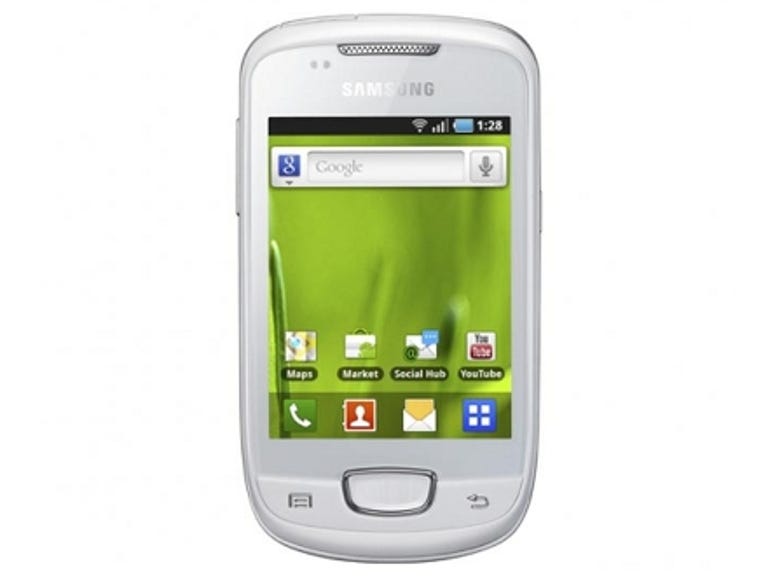 Why You Can Trust CNET
Why You Can Trust CNET Samsung Galaxy Mini review: Samsung Galaxy Mini
The Samsung Galaxy Mini won't suit demanding smart-phone users. But this cheap and cheerful addition to the Galaxy stable is a viable option for newcomers to the Android scene.
After the huge success of the Galaxy S and Galaxy S 2 smart phones, Samsung is looking to expand its Android range with the Galaxy Mini, also known as the GT-S5570. This pint-sized smart phone is not only smaller than its big brothers, it's easier on the wallet.
The Good
The Bad
The Bottom Line
The Mini is available for free on a £15-per-month contract. You can also pick it up on a pay as you go deal or SIM-free for around £145.
Small Galaxy
The Mini certainly lives up to its name -- the handset is positively dwarfed by the Galaxy S 2, although, when compared to other budget Android devices, its dimensions seem less dainty. For example, the phone is only slightly smaller than the LG Optimus One, one of its closest rivals.

Like so many of Samsung's phones these days, the Mini is constructed almost entirely from plastic. Despite the lack of aluminium and brushed metal, the device feels sturdy enough. It doesn't creak when gripped tightly, and the battery cover is well secured. You'll also find that the micro-USB port is protected by a rubber cover -- something that isn't always the case on many modern phones.
The Mini bucks the trend by featuring only three buttons on its front, rather than the usual four. The near-ubiquitous Android 'search' command is missing. The placement of the buttons is also somewhat unusual. The 'home' key is fixed inside what initially looks like a trackpad, but in reality is merely a single button. This arrangement takes some time to get used to, and you'll often find yourself automatically pressing this central button as if it were a means of confirming a menu selection.
Picture imperfect
On the back of the handset, you'll find a 3-megapixel snapper, which is also capable of capturing low-resolution video footage. Sadly, the lack of flash and autofocus curtail the camera's usefulness, and the washed-out images look poor when viewed on your laptop or television.
Trapped within the Mini's modest frame are some distinctly low-end specifications. The 240x320-pixel display is possibly the most disappointing element of the entire package -- it's rather inadequate for surfing the Web and reading emails. Images appear heavily pixellated and reading tiny text is near-impossible.
The upshot of this low resolution is speed. Because it doesn't have to render high-resolution images, the Mini positively whips along, despite its unimpressive 600MHz processor. Moving between applications is a pleasantly swift experience, and the process of navigating Samsung's TouchWiz user interface is never anything but silky-smooth. Hitting the Web is a reasonably nippy experience too, thanks to the inclusion of 3G and Wi-Fi connectivity
The only exception to this swiftness is mobile gaming. While the Mini is perfectly capable of playing many thousands of titles available in the Android Market, it struggles with more graphically complex titles.
Despite the presence of Android 2.2 Froyo, the Galaxy Mini's browser doesn't support Adobe Flash. Like the LG Optimus One, the Mini runs on an ARMv6 CPU, and an ARMv7 chip is required for Flash support. It's also a shame that Samsung didn't launch the handset with Android 2.3 Gingerbread -- HTC managed it with the similarly modest Wildfire S, after all.
The Swype is mightier than the tap
Like so many of Samsung's phones, the Mini ships with the Swype text-input software. This method of typing requires you to draw a line from letter to letter on the virtual keyboard to compose words, thus removing the need to lift your finger from the screen. It's incredibly quick and makes typing on the Mini's cramped 3.1-inch capacitive touchscreen much easier.
While you might expect such a modest device to be frugal when it comes to consuming battery power, we discovered that the Mini isn't any less hungry than the likes of the iPhone 4 and HTC Desire S. We squeezed around two day's worth of moderate usage out of the handset before it required a top-up.
Conclusion
The Samsung Galaxy Mini's nippy performance and Swype software make it an ideal phone for younger users, and those who want to experience Android but don't want to spend all their cash on a high-end phone. But the low-resolution screen, average battery life and lack of gaming clout mean you should also consider rival devices, such as the Galaxy Ace, Acer Liquid Mini and HTC Wildfire S. Still, if your aspirations are kept in check, you might find much to like about this diminutive device.
Edited by Charles Kloet


